Boat Ride in Sundarbans to watch wildlife
Sundarbans National Park is known for its Bengal Tigers and Salt Water Crocodiles. All the visitors to this National Park wish to see a Bengal Tiger but we know that luck plays a major part in viewing wildlife, especially to sight the Lord of the Jungle. So we didn’t have much expectation to see Tiger. But Vinod had pinned his hopes on seeing a large salt water crocodile. To be frank, I’m not a big fan of reptiles. I just wanted to enjoy the beauty of Sundarbans.
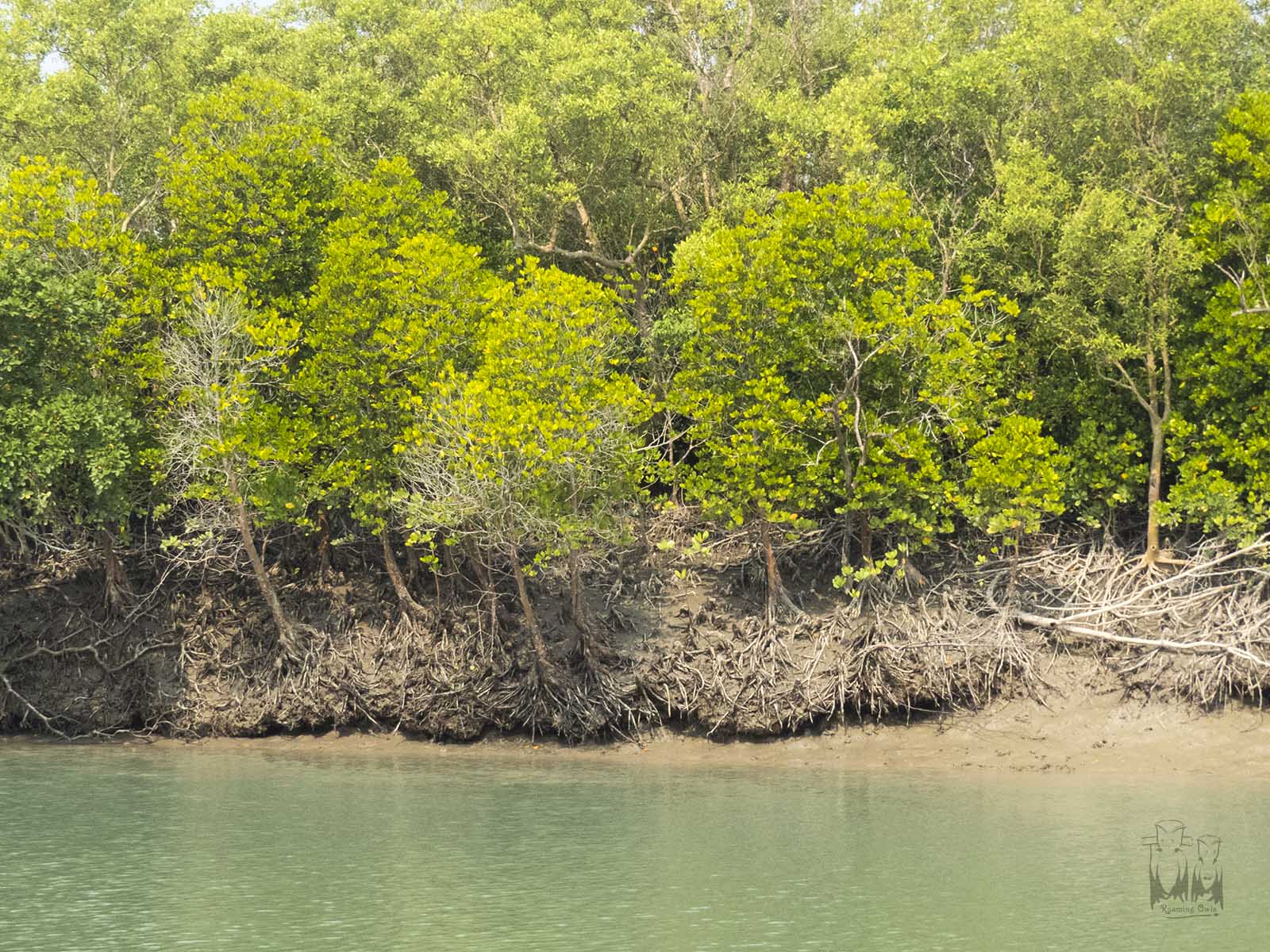
The beautiful mangroves in Sundarbans National Park
We stayed in one of the Eco Villages on the edges of the forest and we had to reach Sundarbans National Park early to start our birding. Since early morning is the best time to see birds, everyone got ready for the boat ride before sunrise. Once we got the permit from the Forest Department, we entered into the Sundarbans National Park with a local guide appointed by forest department. Near the villages we spotted only White-Breasted Kingfisher and Langurs. On the mudflats near the Forest Department we saw mudskippers jumping around.
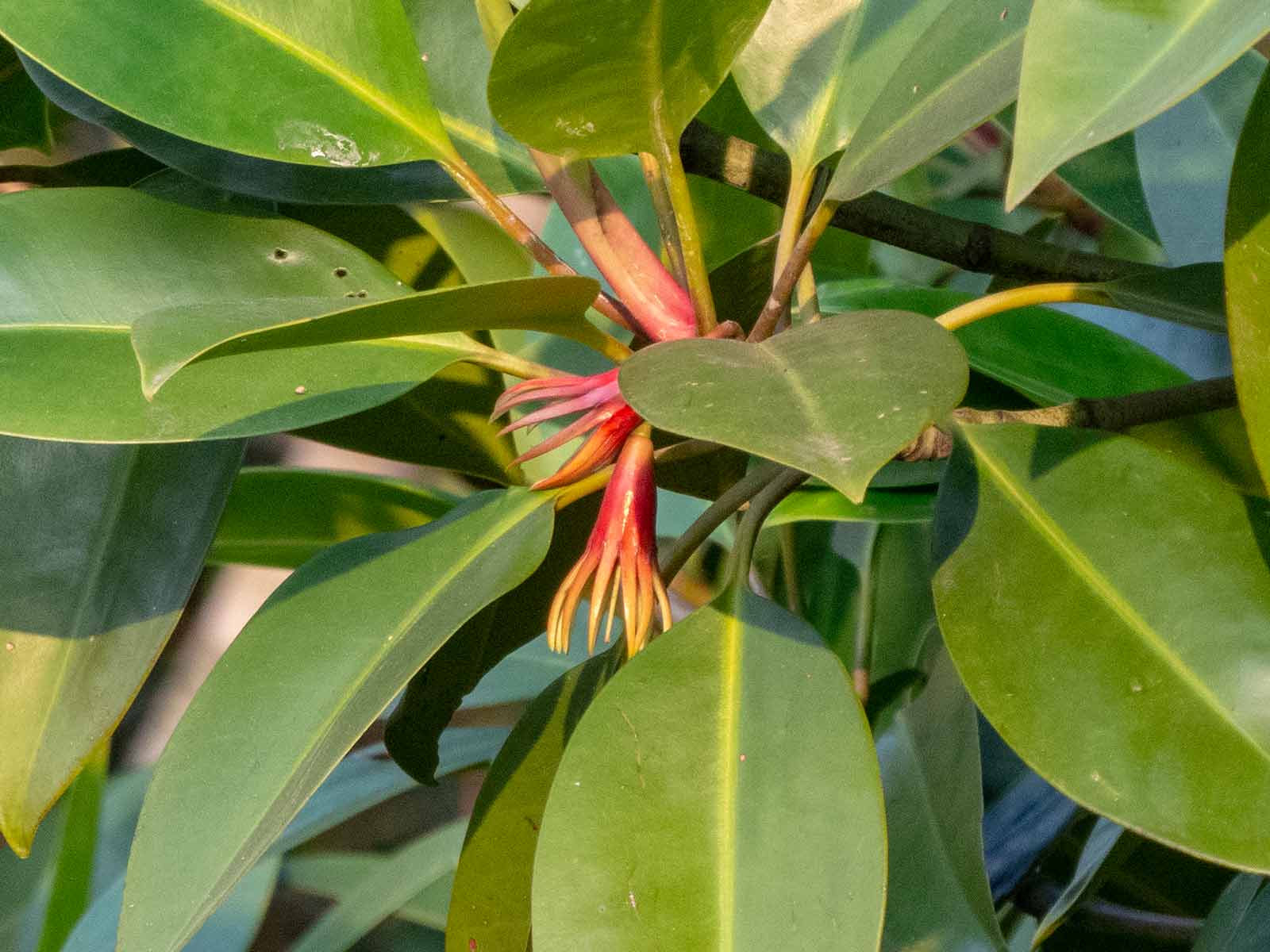
Flowers of the mangrove trees are unique. They are not as flamboyant like the regular ones, often they green in colour
Once into the national park, Vinod and I started watching keenly for birds and other wildlife on the mudflats. The terrain was so beautiful with tidal water ways and mangroves. Heritiera fomes is the most commonly found mangrove in Sundarbans and is locally called as “Sundari”. In a mangrove ecosystem, other plant species normally don’t survive because the thick canopy of mangroves don’t allow sunlight inside and also because of salt water. Only mangrove root system can tolerate the salt water with its unique filteration method. The mangrove root system looked very complex and beautiful. The complex root system also helps in retaining the mud and helps to prevent erosion. We were enjoying the mangroves but no sight of any wildlife except for Black-capped Kingfisher.
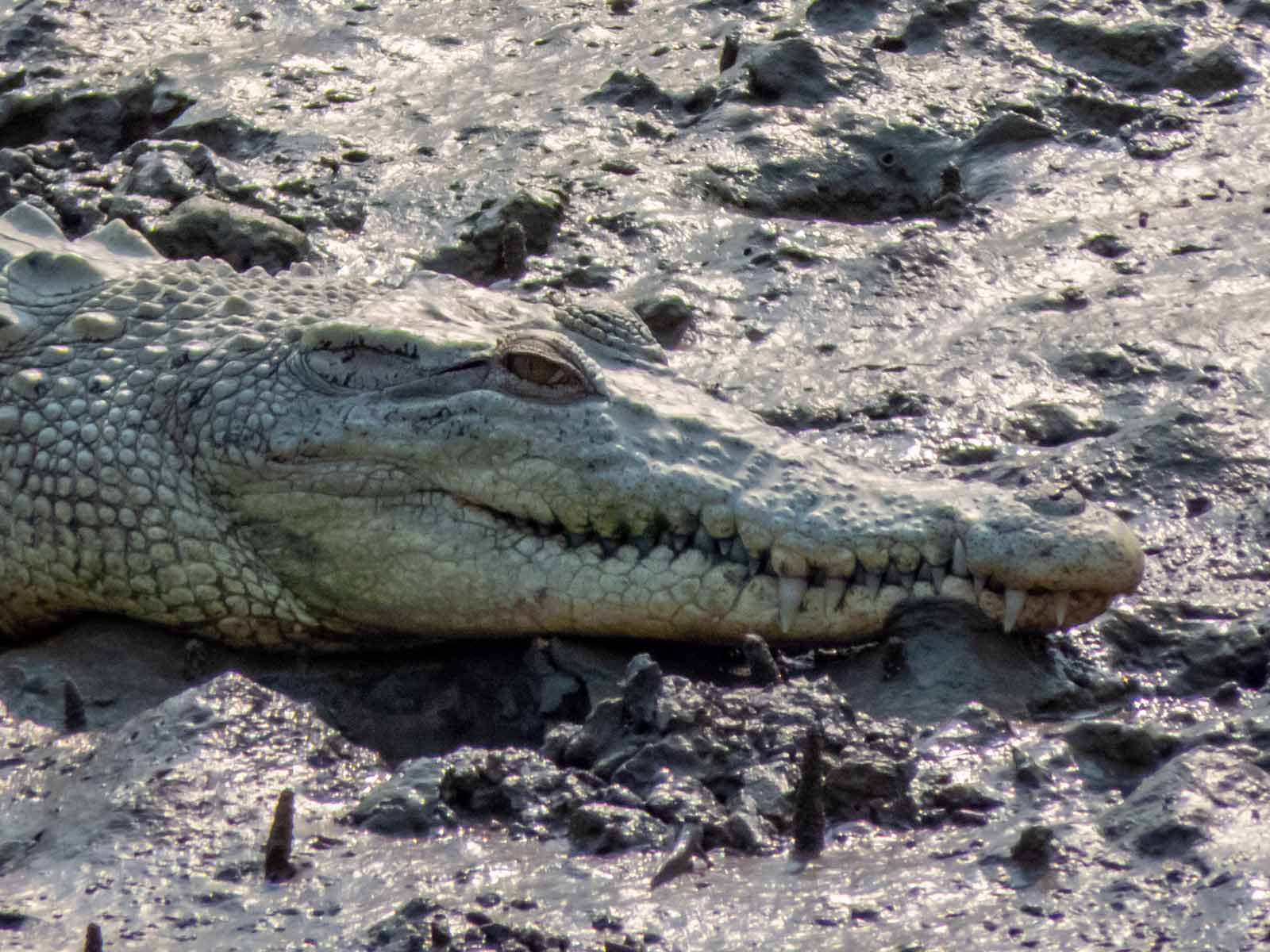
Salt water crocodiles are the largest reptiles of the world. Because of our biased mainstream media we always look to foreign countries for wildlife but in India we still have places where we can find really huge crocodiles.
The unique ecosystem found in the mesh of mangrove roots offers a safe region for young marine organisms. The guide from forest department was telling us about the Sundarbans, but all our eyes were wandering outside. Suddenly we heard a splash. We all jumped and ran to see a big crocodile just getting into the water. We were all very disappointed to miss the crocodile. After few minutes, our guide MJ spotted a crocodile. None of us could see it and only after several directions, we spotted a log and to our great surprise we were told that’s the crocodile. No one could believe that it was a crocodile, as it was so small and motionless. Only when we looked through binoculars, we believed it was a crocodile.
While we were all searching for wildlife, food was getting cooked in the boat and we were served hot delicious breakfast. Once our stomach were full, we continued our wildlife watching.
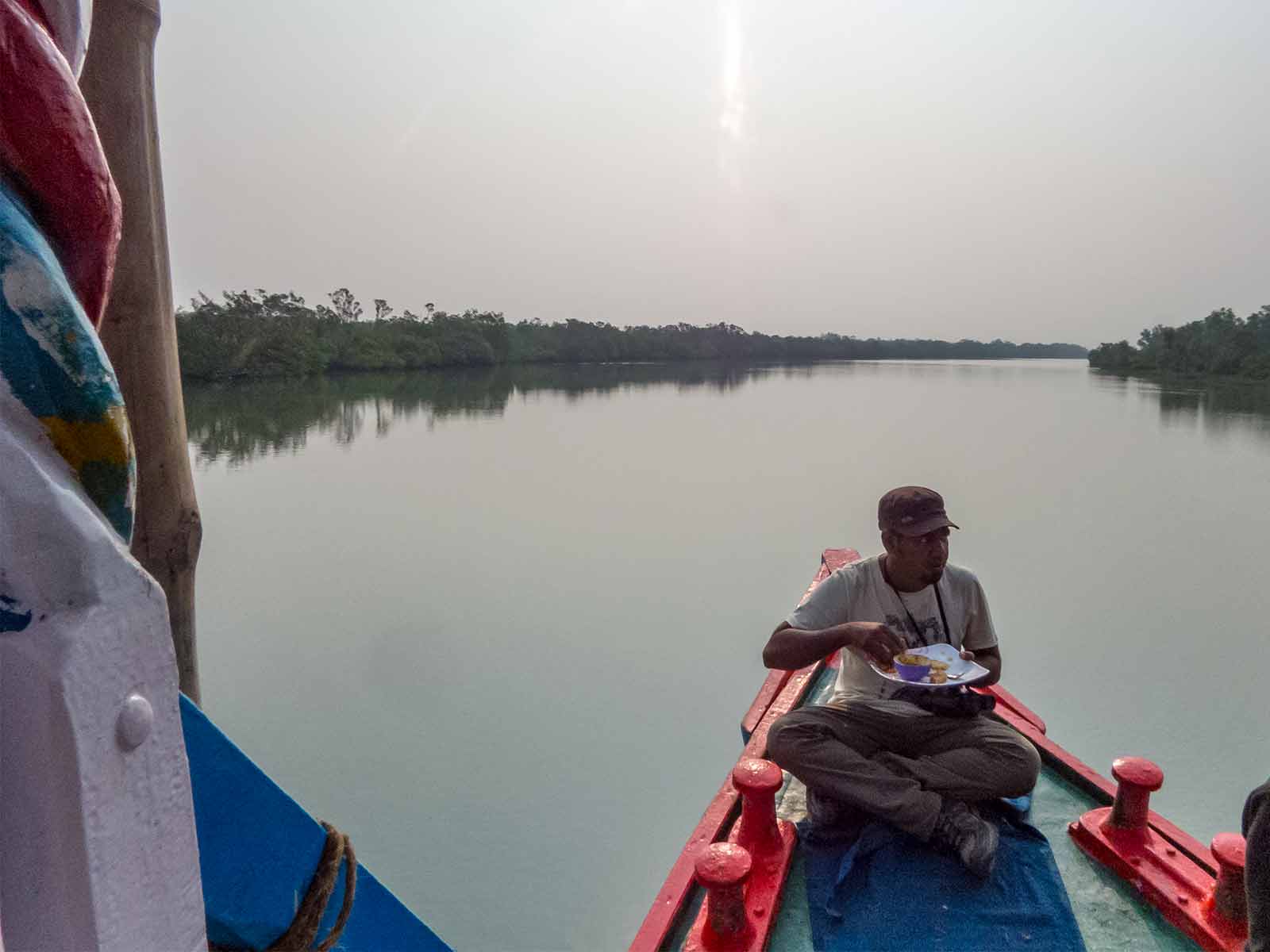
The boatride we took offered us breakfast too. Sitting on the tip of a boat and cruising the sundarbans searching for crocodiles all the while eating poori ?! I never thought I will do this !
Apart from the guides, we were the only birders in the group. So we ended up showing the birds to our co-travellers. After a little while, Vinod spotted a big monitor lizard. It was casually grazing around the bank. Seeing any wild animal is always exciting, and if that animal is a big one, it’s always so thrilling and exciting.
Suddenly the energy in the boat increased. Everyone started talking about their own wildlife encounters. When we were all chatting, a big bird flew and landed inside the mangrove forest. It was the lesser adjutant stork but it was well hidden inside the bushes and we couldn’t see it clearly.
There are two viewpoints inside the Sundarbans National Park. We reached the first watch tower about 11.00 am. When we got down from the boat, the mudbanks was filled with colorful crabs . Crabs are always so funny when you look closely. They were waving one hand and chasing each other.
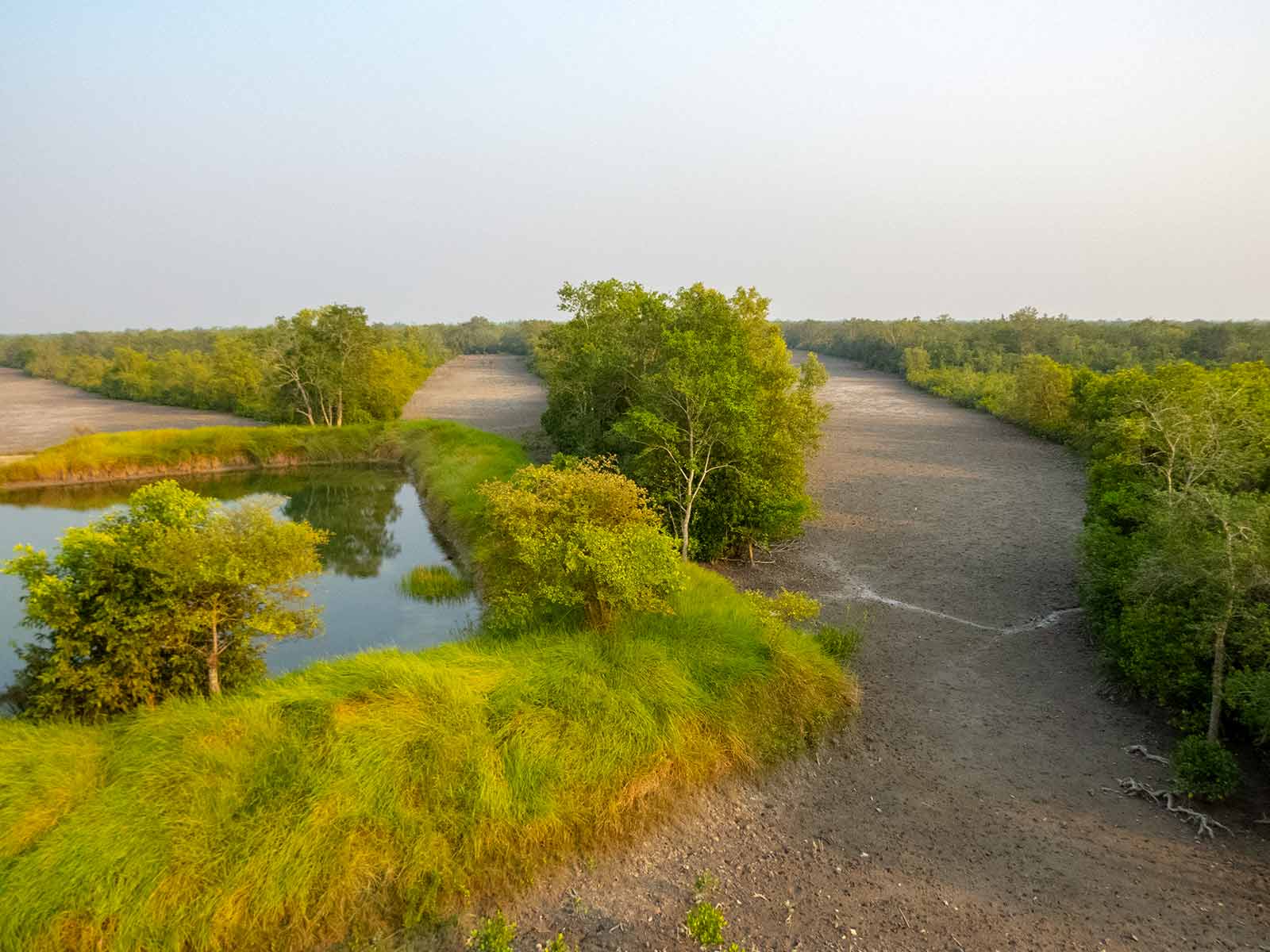
A view of the waterways waiting for the tide to return. The water in the picture is fresh water and so animals come here for a drink most of the times.
The short walk to the watch tower was not very eventful as its already late morning. Still we all searched for tiger, if only we could get a glimpse of it !!
As we were moving continuously, inside the boat we didn’t feel the heat. But in the watch tower it was sizzling. Back in the boat, hot tea was served and just when everyone was drinking tea and distracted , the boat driver spotted a big crocodile. The crocodile got disturbed by the engine sound and quickly moved to the water. In seconds, none could spot the crocodile in the water. How Scary!! There was not even a slight movement in the water. As we were in a big boat, we returned back to our seats and continued drinking our tea and started talking excitingly about the incident. How different the situation would have been, If we were in a small boat!!
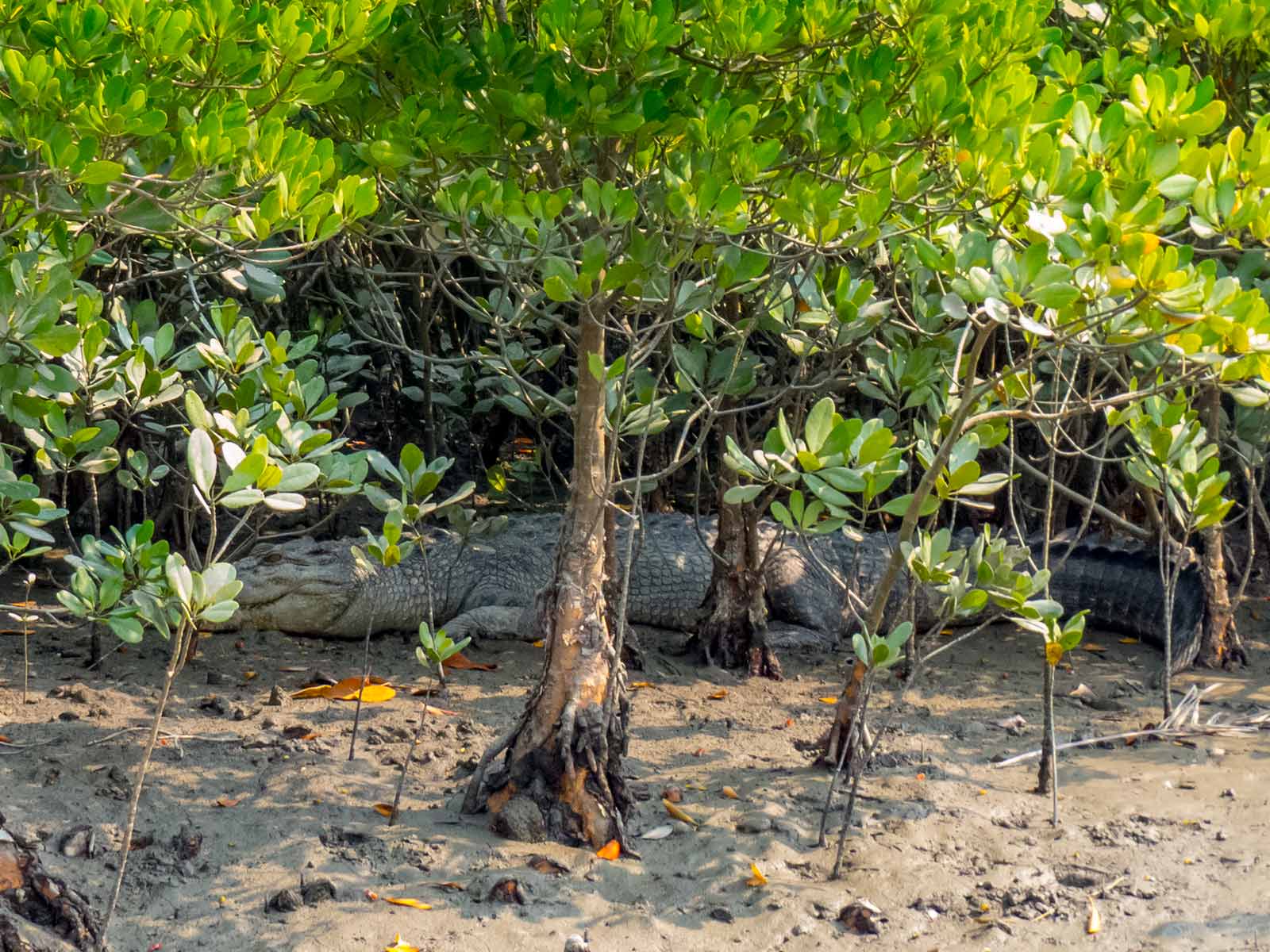
A big saltwater crocodile or estuarine crocodile lying among the mangroves.
It was like a jinx had been lifted, once we spotted the crocodile , we began spotting few more crocodiles and water monitor lizards.
Meanwhile delicious lunch was ready in the boat. We eagerly ate all the local dishes, while enjoying the scenery. Not everyday do you get a chance to ride on a boat, watch big mammals and eat delicious meals! So when we got the chance, we enjoyed it every bit! Even while eating, all our eyes were searching for wildlife on the banks. Wild boars were running around and our guide MJ was telling us about the local people hunting boars for food. He also added, the locals even ate the mudskippers!
Birds in Sundarbans
While we were all searching for big mammals and reptiles, I was searching for the Ruddy Breasted Kingfisher and the Brown winged kingfisher which could be spotted in the Sundarbans. When I was about to lose hope that we were not going to see these kingfishers in this trip, I spotted Brown winged kingfisher. Though the bird was colorful, it needs a trained eye to spot it.
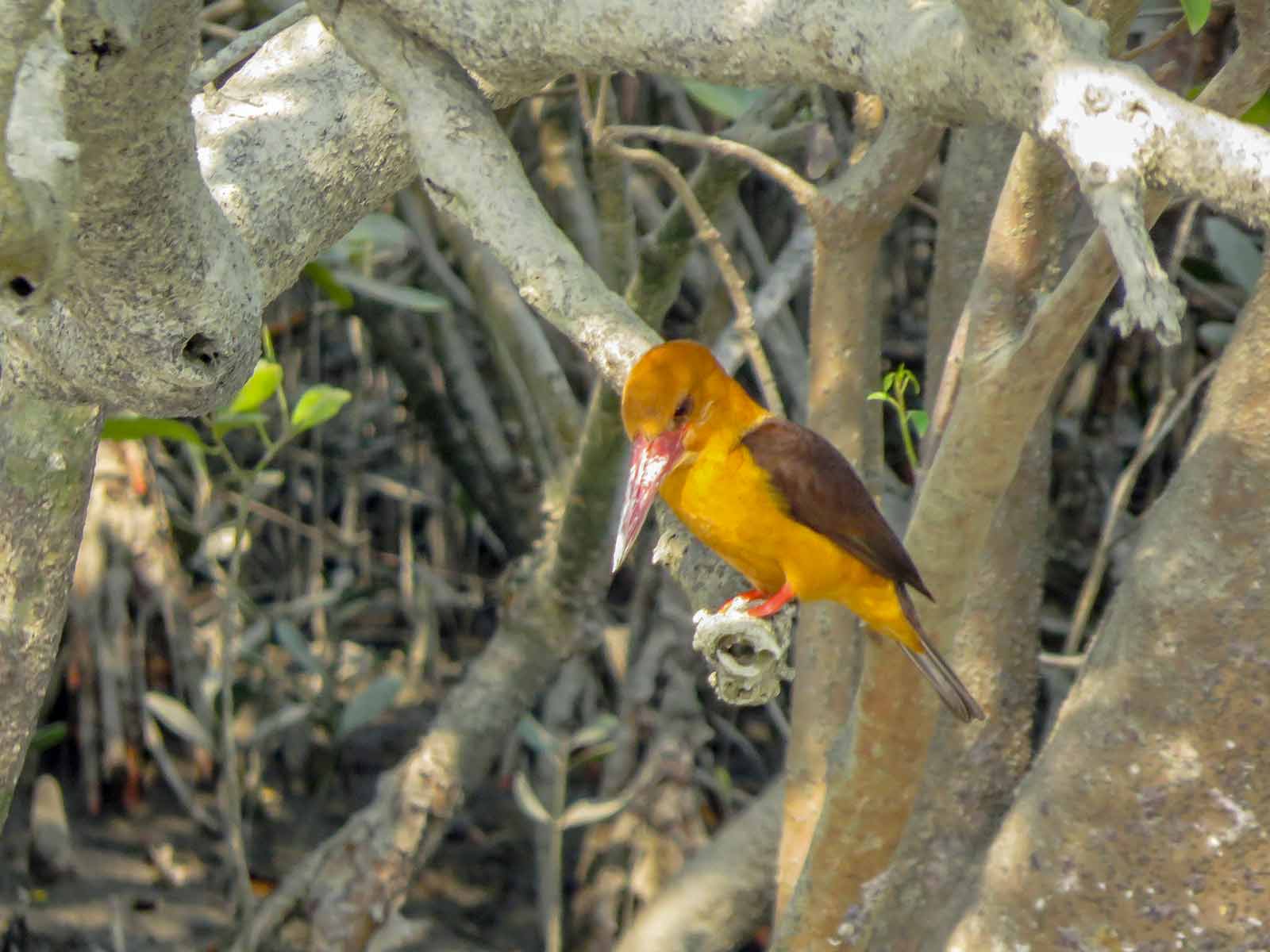
We spotted brown winged kingfisher keenly fishing among the mangroves. As we slowly approached with the boat , we managed a few clicks before he took off.
Like other kingfishers this one also sat patiently on a branch keenly watching the water. Suddenly it flew down and caught a fish and went inside the mangrove. Really was it an easy lunch or tough lunch? In a Layman’s eye all kingfishers look alike. As we were the only birders in the boat, we shared our knowledge about this Brown winged kingfisher and why we were so excited seeing it.
When everyone was eagerly searching for a tiger, I was happy seeing all the little things from crab to mangrove flower. What added to my happiness on this trip was the cutest thing – A family of deer very casually eating and the fawn was so happily jumping around, without a tiny bit of worry in the world. When everyone told, “Oh its just a deer”, I felt the opposite. I felt an immense happiness in seeing them. They are a real family, raising a kid in a wild environment, where anything can happen at any moment, but at that moment the fawn had nothing to worry.
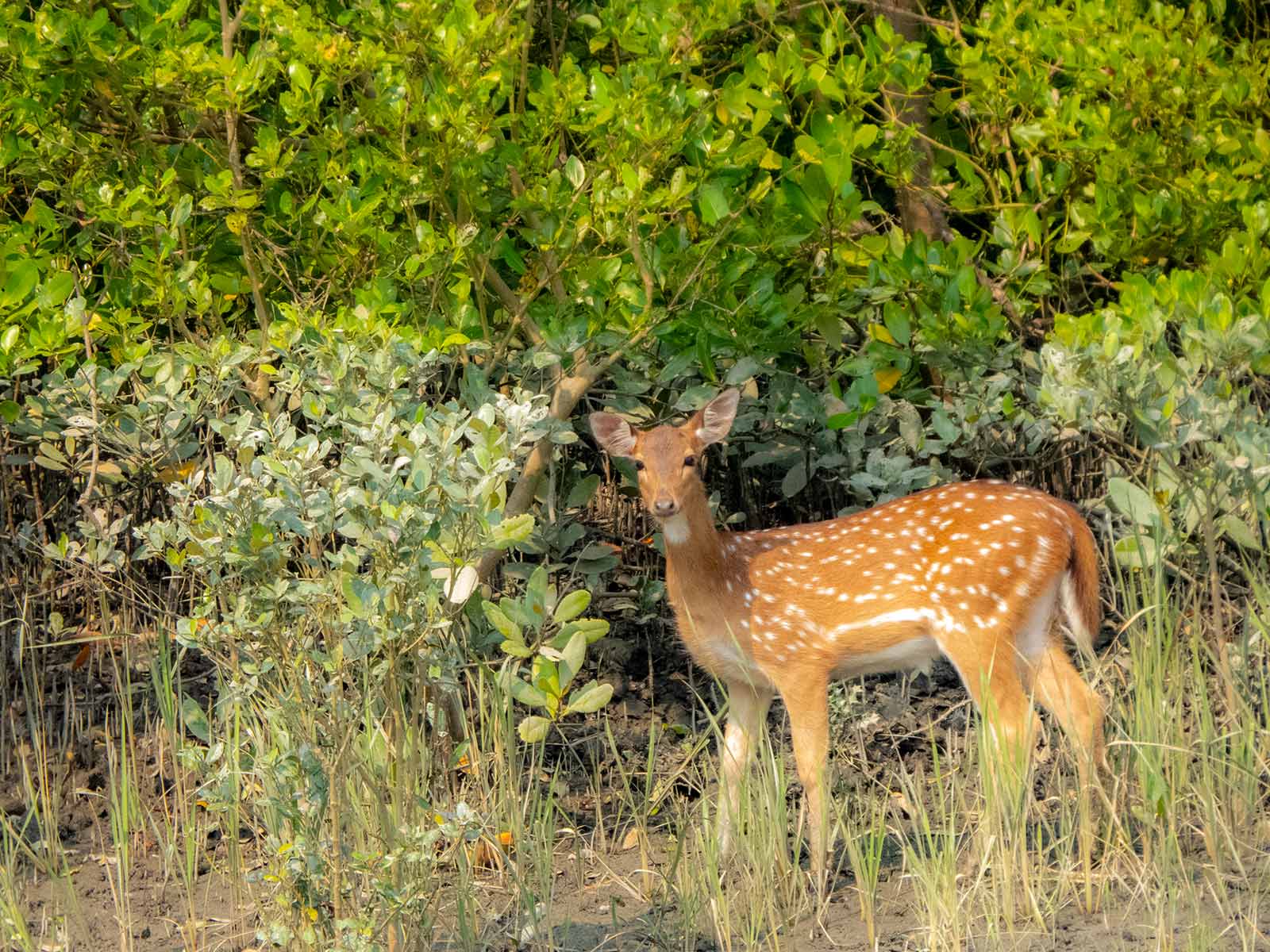
The ever so beautiful spotted-deer. The glowing light made it a treat to watch as they casually roamed around.
Everyone loves to see the predators in the forest and if we don’t get to see a tiger we will be told that we were unlucky. But these little moments you see and enjoy in the forest is what brings you closer to the forest. You will understand then, that all these wild animals have families just like us.
Carried by that thought , we reached the second view point. This is the place where tigers were spotted frequently but we saw just monitor lizard grazing around.
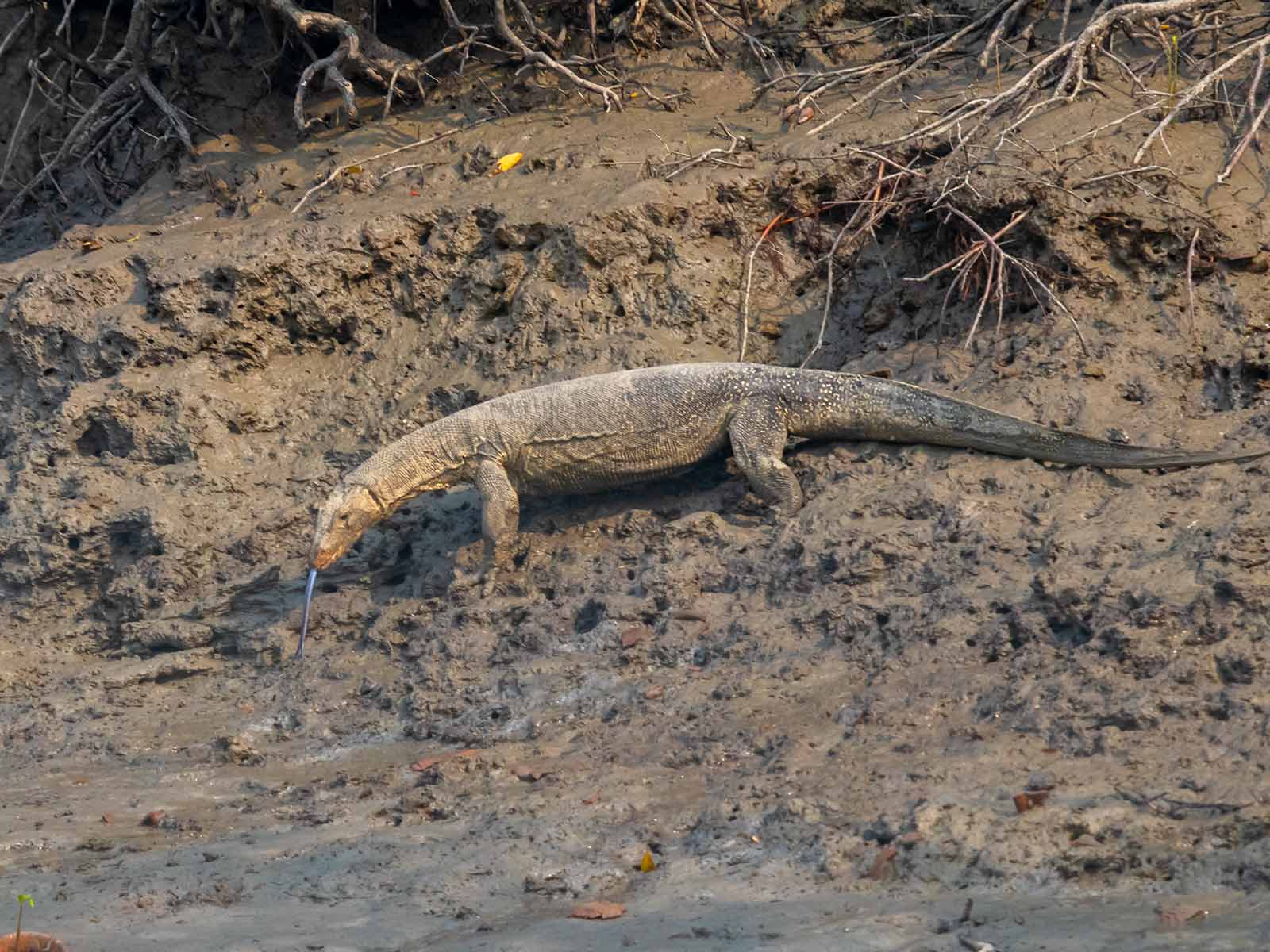
With it’s long tongue the Bengal monitor lizard was tasting the air as it went around looking for something to eat.
When we were all searching inside the mangroves, a Black hooded oriole casually flew up to the nearby dried up tree. So we distracted our fellow travelers to see this colorful bird. As this is a canopy bird, usually taking photo of this bird itself is tough. But to our luck we even got a video.
Back to the boat, with yet another cup of black tea !! We were keenly watching for any wildlife activities for sure but we had to say this was unlike any other wildlife safari we had gone. It was parallel food safari as well ! As we were well fed and sat on the boat the entire day, we were still fresh in the evening. Our Co-travellers still didn’t lose hope to see a tiger. Instead of stripes on the bank, we saw a sticky tall feathered one pecking on the crabs walking on the mudflats – the Lesser Adjutant Stork , which had earlier in the day flown into the bushes. This bird is famous for its adaptation to get food by scavenging and hence has a bald head like that of vultures. We were happy to see the stork in its wild terrain.
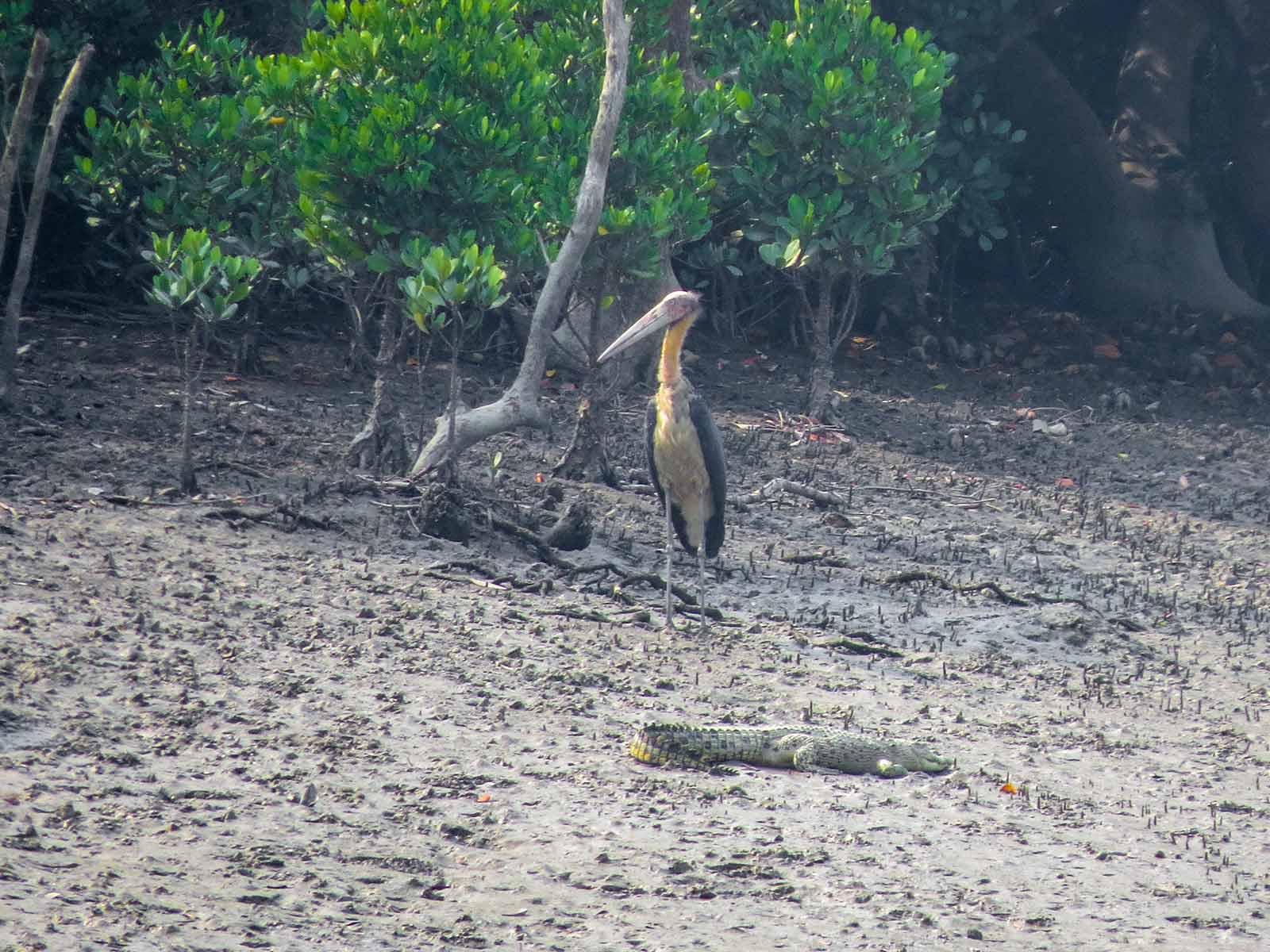
The lesser adjutant stork stands nearly 4 feet tall but the size difference is only because the crocodile was a juvenile !
It didn’t mind us at all and continued eating. It may not be beautiful, nevertheless it has its own uniqueness.
By this time the sun had started setting down and the time for us to return to the crowded streets of Kolkata were upon us. We couldn’t imagine going from this peaceful place to the non-stop hectic city. Though we didn’t see a tiger, we were happy with the birds and the crocodiles. Like we always say, wildlife watching is not just about tigers or rare birds, it is the understanding of all life regardless of size and shape. It is understanding that in the very same world, there could be different ways of living and being happy. In this trip, we marveled at the mangroves and found how even such a tough terrain supports so much wildlife.
Beauty in a SNOW covered world
Watch the beautiful songs of Indian birds below :